人教版必修五Unit 1 Great scientists Reading课件(35张ppt)
文档属性
| 名称 | 人教版必修五Unit 1 Great scientists Reading课件(35张ppt) |  | |
| 格式 | zip | ||
| 文件大小 | 911.2KB | ||
| 资源类型 | 教案 | ||
| 版本资源 | 人教版(新课程标准) | ||
| 科目 | 英语 | ||
| 更新时间 | 2019-11-19 20:23:37 | ||
图片预览

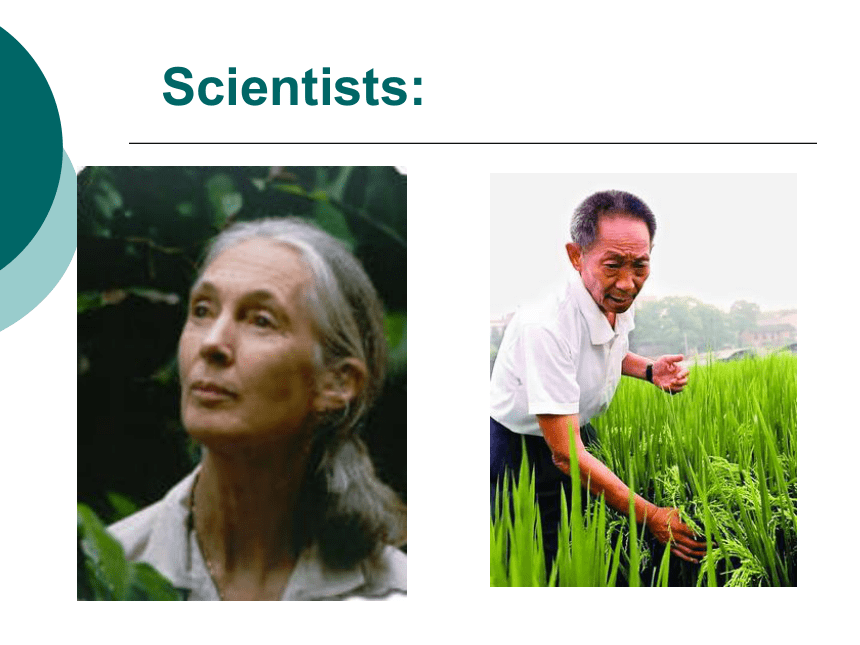


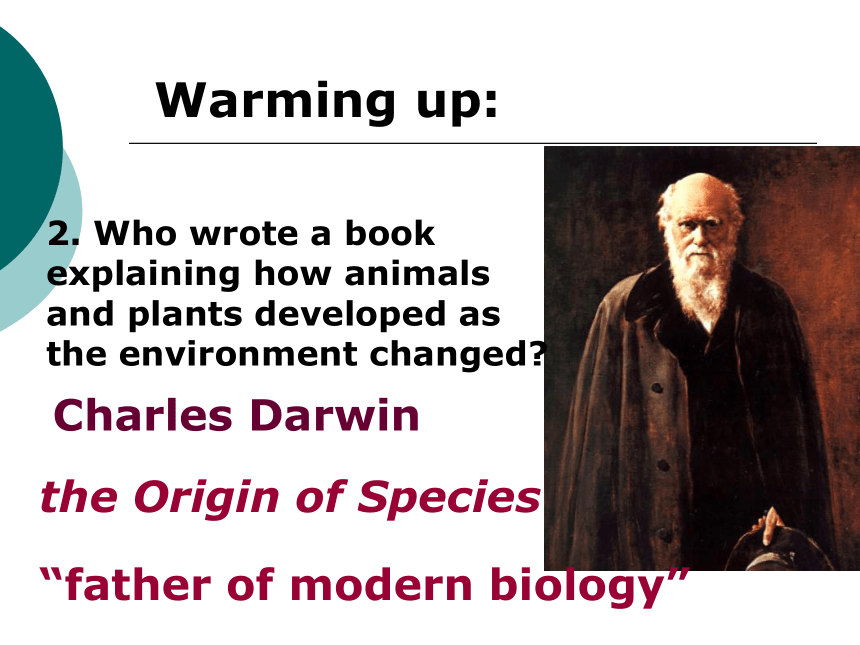
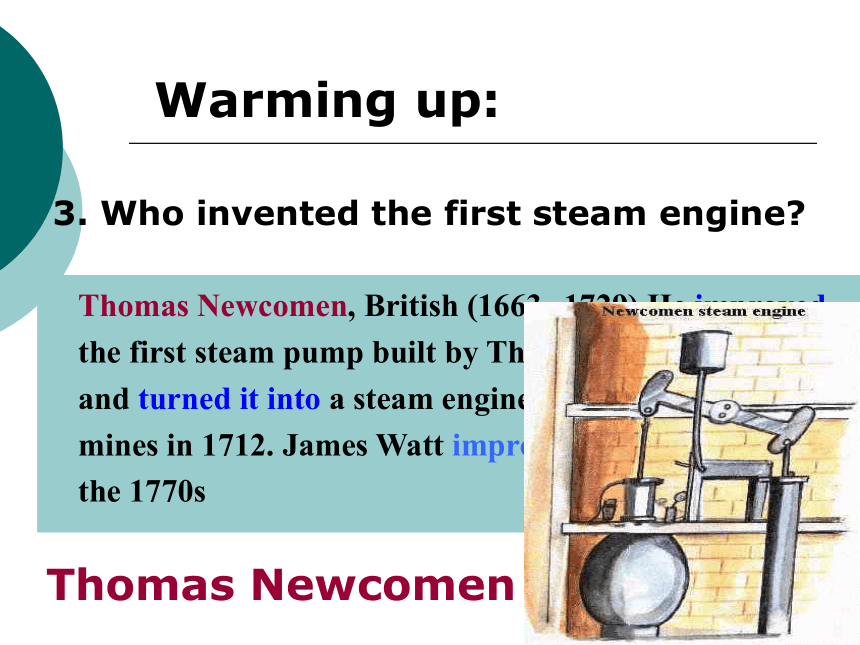
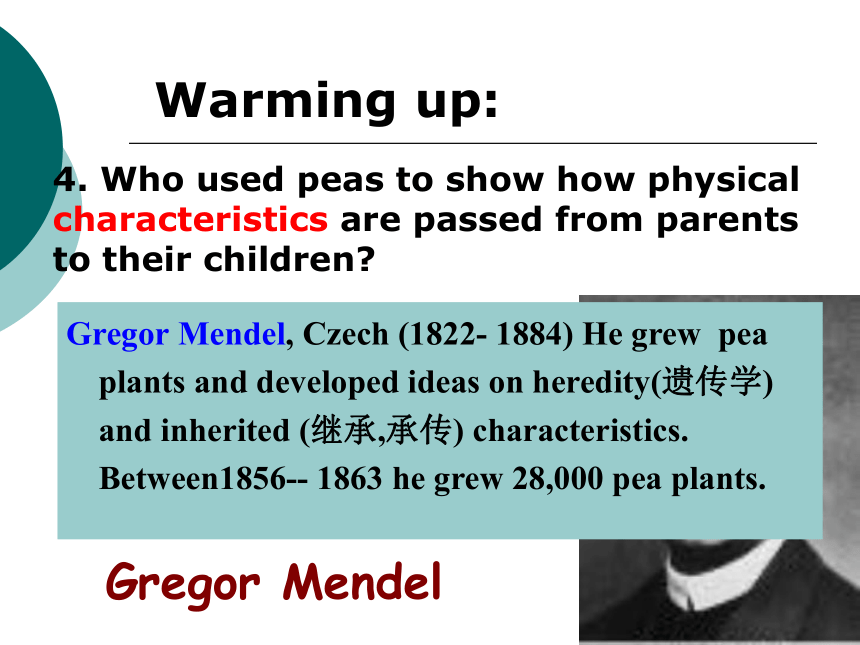
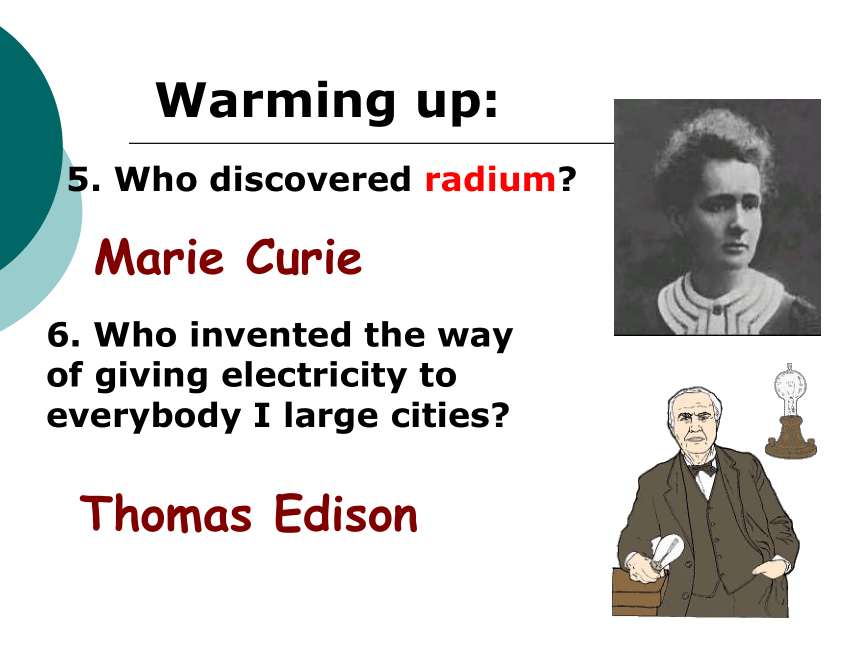
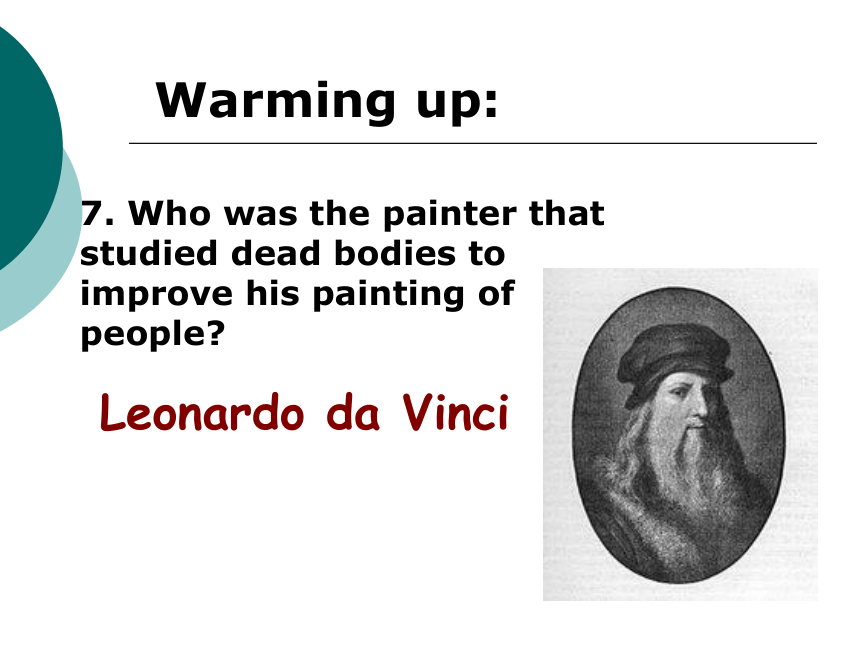
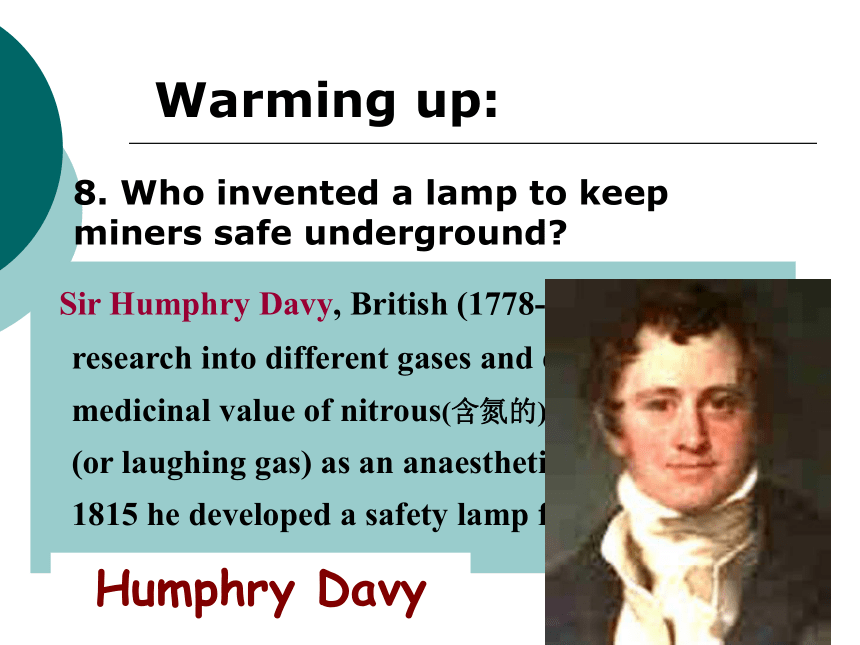
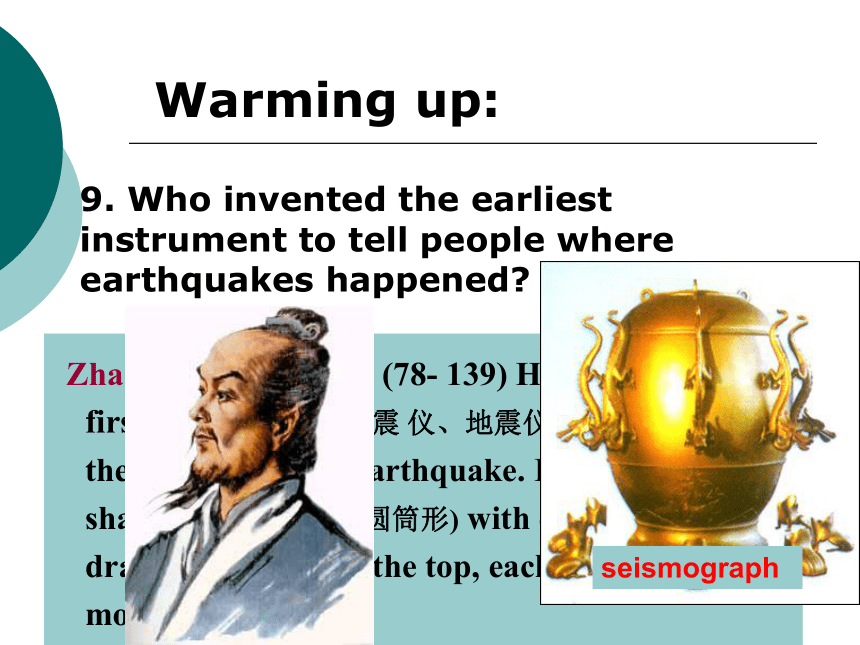
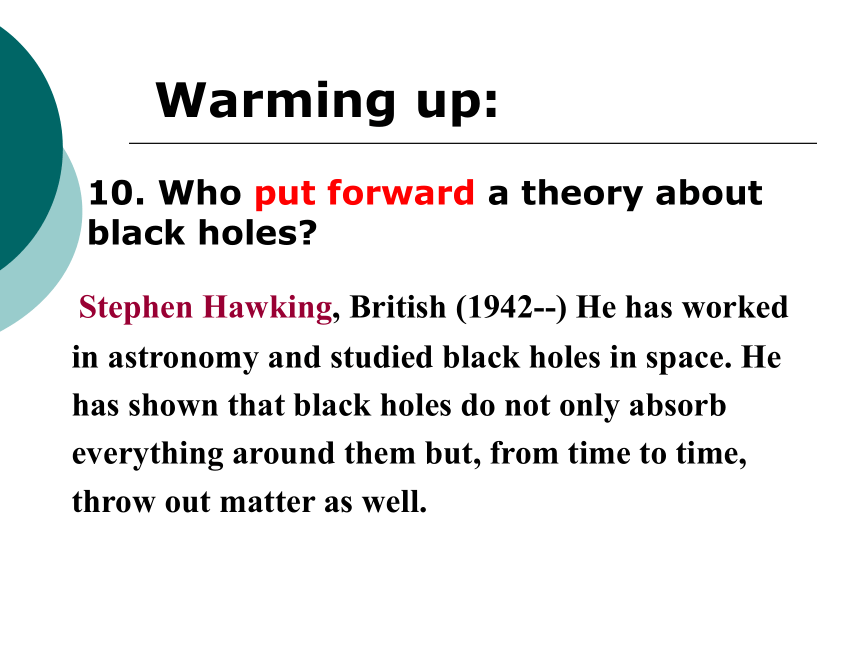
文档简介
(共35张PPT)
Unit 1 Great Scientists
Reading
Scientists:
Alexander Bell electricity
Thomas Edison the First telephone
Wright Brothers the electric Lamp
Madame Curie black holes in Universe
Franklin Theory of Gravity
Steven Hawking the First Plane
Elbert Einstein Radium
Isaac Newton the Theory of Relativity
Scientists & Contributions:
Archimedes
(阿基米德)
Warming up:
1. Which scientist discovered that objects in water are lifted up by a force that helps them float?
Ancient Greek
(287-212BC)
A mathematician
Charles Darwin
2. Who wrote a book explaining how animals and plants developed as the environment changed?
the Origin of Species
Warming up:
“father of modern biology”
3. Who invented the first steam engine?
Thomas Newcomen, British (1663--1729) He improved the first steam pump built by Thomas Savery in 1698 and turned it into a steam engine for taking water out of mines in 1712. James Watt improved it still further in the 1770s
Thomas Newcomen
Warming up:
Gregor Mendel, Czech (1822- 1884) He grew pea plants and developed ideas on heredity(遗传学) and inherited (继承,承传) characteristics. Between1856-- 1863 he grew 28,000 pea plants.
Gregor Mendel
4. Who used peas to show how physical characteristics are passed from parents to their children?
Warming up:
Marie Curie
Warming up:
5. Who discovered radium?
6. Who invented the way of giving electricity to everybody I large cities?
Thomas Edison
新课标第一网:
Leonardo da Vinci
7. Who was the painter that studied dead bodies to improve his painting of people?
Warming up:
Sir Humphry Davy, British (1778- 1829) He did research into different gases and discovered the medicinal value of nitrous(含氮的) oxide(氧化物) (or laughing gas) as an anaesthetic(麻醉剂). In 1815 he developed a safety lamp for miners.
Humphry Davy
8. Who invented a lamp to keep miners safe underground?
Warming up:
Zhang Heng, Chinese (78- 139) He invented the first seismograph(测震 仪、地震仪) to indicate in the direction of an earthquake. It was in the shape of a cylinder(圆筒形) with eight dragonheads round the top, each with a ball in its mouth.
9. Who invented the earliest instrument to tell people where earthquakes happened?
Warming up:
seismograph
Stephen Hawking, British (1942--) He has worked in astronomy and studied black holes in space. He has shown that black holes do not only absorb everything around them but, from time to time, throw out matter as well.
10. Who put forward a theory about black holes?
Warming up:
common characteristics
cautious
persuasive
strict
positive
Co-operative
creative
bright
enthusiastic
Draw a conclusion
Draw a conclusion
They all...
made a great contribution.
made great achievements.
succeeded in their scientific career.
overcome many difficulties.
invent v. 发明, 发明原先不存在的东西
Who invented the steam engine?
谁发明了蒸汽机?
discover v. 发现, 探索或揭示早就客观存在着事物
Columbus discovered America in 1492.
哥伦布于1492年发现了美洲。
Who discovered radium? 谁发现了镭?
Language Points
1)The tradition is ___________ their ancestors.
2) This spirit should be passed ______ from
generation to generation.
3) Pass the letter ___ to the person next to you.
4) So many people pass ___ and never notice
the change.
passed from
down
on
by
pass sth from… 从……处传来, 传下
pass by 路过,经过……
pass down 把……传下来
pass on 传递,传授
put forward
(1) 提出(建议等)
(2) 推荐某人或自己任职位; 提名
我能否提名你当我们的班长?
May I put your name forward as our monitor?
The match has been put forward to 1:30.
比赛已经提前到一点半举行。
1.他在会议上提出了一个计划。
He put forward a plan at the meeting.
2.他们把婚礼的日期提前了一周。
They put forward the date of their wedding by one week.
3.我们将把讲座的日期提前/延期到9月9号。
We’ll put forward/put off the date of the lecture to September 9th.
put on 穿上;戴上;增加
put off 耽误;延期
=put up 建立;建造
put up with… 忍受……
Pre-reading:
draw a conclusion
Think of a method
Collect results
Make a question
Find a problem
Analyse the results
Find supporting evidence
①
③
②
④
⑤
⑥
⑦
Stages in setting out a new scientific idea:
Dicussing
infectious diseases :
They can be spread to other people.
They have an unknown cause.
They are difficult to cure.
They need public health care to solve them.
Pre-reading:
Big eyes
dbrandfadvancehtuswingbs
varioussldeedqtamusement
themechtranslatorpunique
null
Big eyes
dexpertndexposecsuspectg
victimsenquirytannouncet
tinstructnsblamerphandle
null
Big eyes
dexpertndexposecsuspectg
victimsenquirytannouncet
tinstructnsblamerphandle
null
Skimming::
Who was the great scientist in the passage and what was the deadly disease of its day?
John Snow
cholera
Cholera:
It begins in the stomach and a severe case can lead to death without immediate treatment.
And the victims died very quickly from a loss of liquid after severe vomiting(呕吐) and diarrhoea(腹泻).
Steps: What/How?
1.Find a
problem
2.Make up a
question
3.Think of a
method
4.Collect
results
Fast reading and getting main idea
What causes cholera?
Which theory is correct?
Gather information when another Cholera hit London in 1854.
He marked on a map where all the dead people had lived.
6. Find supporting evidence
7.Draw a conclusion
5.Analyse
results
Looked into the source of the water.
Two other deaths.
The water is to blame. The source of all drinking water should be examined.
Careful Reading:
John Snow was an doctor in London who Queen Victoria as her personal . He thought about helping ordinary people to cholera. Though the cause and the of it were unknown, he wanted to face
the and solve the problem.
para.1
expert
attended
physician
exposed
cure
challenge
Careful Reading:
What were the two theories about the cause of cholera?
Which did John Snow want to prove?
What was his method of doing the research?
…multiplied… …victims…
…absorb…
The second one.
To gather information in two particular streets.
para.2&3
Careful Reading:
para.4
What did he do with the results of his enquiry?
What valuable clue did he get about the cause of the disease?
What might be the cause?
Marked on a map…
Many of the deaths…
…had no deaths.
It seemed that the water was to blame for cholera.
Many of the deaths were near the water pump in Broad Street.
death
Part of Snow’s Cholera Map
Careful Reading:
para.5
Why did he tell people to remove the handle from the pump?
What happened after the handle was removed?
So that …
…slowed down
Careful Reading:
para.6&7
Where did the woman live and what did she had delivered to her house every day?
What did their deaths suggest?
What measures did John Snow take to prevent the disease from spreading?
Away from Broad Street
Water from the pump
The polluted water carried the virus
..suggested that…be examined
…were instructed not to expose…to…
Read the text and learn the new words by heart
Find more information about cholera and John Snow on the Internet.
Homework:
Unit 1 Great Scientists
Reading
Scientists:
Alexander Bell electricity
Thomas Edison the First telephone
Wright Brothers the electric Lamp
Madame Curie black holes in Universe
Franklin Theory of Gravity
Steven Hawking the First Plane
Elbert Einstein Radium
Isaac Newton the Theory of Relativity
Scientists & Contributions:
Archimedes
(阿基米德)
Warming up:
1. Which scientist discovered that objects in water are lifted up by a force that helps them float?
Ancient Greek
(287-212BC)
A mathematician
Charles Darwin
2. Who wrote a book explaining how animals and plants developed as the environment changed?
the Origin of Species
Warming up:
“father of modern biology”
3. Who invented the first steam engine?
Thomas Newcomen, British (1663--1729) He improved the first steam pump built by Thomas Savery in 1698 and turned it into a steam engine for taking water out of mines in 1712. James Watt improved it still further in the 1770s
Thomas Newcomen
Warming up:
Gregor Mendel, Czech (1822- 1884) He grew pea plants and developed ideas on heredity(遗传学) and inherited (继承,承传) characteristics. Between1856-- 1863 he grew 28,000 pea plants.
Gregor Mendel
4. Who used peas to show how physical characteristics are passed from parents to their children?
Warming up:
Marie Curie
Warming up:
5. Who discovered radium?
6. Who invented the way of giving electricity to everybody I large cities?
Thomas Edison
新课标第一网:
Leonardo da Vinci
7. Who was the painter that studied dead bodies to improve his painting of people?
Warming up:
Sir Humphry Davy, British (1778- 1829) He did research into different gases and discovered the medicinal value of nitrous(含氮的) oxide(氧化物) (or laughing gas) as an anaesthetic(麻醉剂). In 1815 he developed a safety lamp for miners.
Humphry Davy
8. Who invented a lamp to keep miners safe underground?
Warming up:
Zhang Heng, Chinese (78- 139) He invented the first seismograph(测震 仪、地震仪) to indicate in the direction of an earthquake. It was in the shape of a cylinder(圆筒形) with eight dragonheads round the top, each with a ball in its mouth.
9. Who invented the earliest instrument to tell people where earthquakes happened?
Warming up:
seismograph
Stephen Hawking, British (1942--) He has worked in astronomy and studied black holes in space. He has shown that black holes do not only absorb everything around them but, from time to time, throw out matter as well.
10. Who put forward a theory about black holes?
Warming up:
common characteristics
cautious
persuasive
strict
positive
Co-operative
creative
bright
enthusiastic
Draw a conclusion
Draw a conclusion
They all...
made a great contribution.
made great achievements.
succeeded in their scientific career.
overcome many difficulties.
invent v. 发明, 发明原先不存在的东西
Who invented the steam engine?
谁发明了蒸汽机?
discover v. 发现, 探索或揭示早就客观存在着事物
Columbus discovered America in 1492.
哥伦布于1492年发现了美洲。
Who discovered radium? 谁发现了镭?
Language Points
1)The tradition is ___________ their ancestors.
2) This spirit should be passed ______ from
generation to generation.
3) Pass the letter ___ to the person next to you.
4) So many people pass ___ and never notice
the change.
passed from
down
on
by
pass sth from… 从……处传来, 传下
pass by 路过,经过……
pass down 把……传下来
pass on 传递,传授
put forward
(1) 提出(建议等)
(2) 推荐某人或自己任职位; 提名
我能否提名你当我们的班长?
May I put your name forward as our monitor?
The match has been put forward to 1:30.
比赛已经提前到一点半举行。
1.他在会议上提出了一个计划。
He put forward a plan at the meeting.
2.他们把婚礼的日期提前了一周。
They put forward the date of their wedding by one week.
3.我们将把讲座的日期提前/延期到9月9号。
We’ll put forward/put off the date of the lecture to September 9th.
put on 穿上;戴上;增加
put off 耽误;延期
=put up 建立;建造
put up with… 忍受……
Pre-reading:
draw a conclusion
Think of a method
Collect results
Make a question
Find a problem
Analyse the results
Find supporting evidence
①
③
②
④
⑤
⑥
⑦
Stages in setting out a new scientific idea:
Dicussing
infectious diseases :
They can be spread to other people.
They have an unknown cause.
They are difficult to cure.
They need public health care to solve them.
Pre-reading:
Big eyes
dbrandfadvancehtuswingbs
varioussldeedqtamusement
themechtranslatorpunique
null
Big eyes
dexpertndexposecsuspectg
victimsenquirytannouncet
tinstructnsblamerphandle
null
Big eyes
dexpertndexposecsuspectg
victimsenquirytannouncet
tinstructnsblamerphandle
null
Skimming::
Who was the great scientist in the passage and what was the deadly disease of its day?
John Snow
cholera
Cholera:
It begins in the stomach and a severe case can lead to death without immediate treatment.
And the victims died very quickly from a loss of liquid after severe vomiting(呕吐) and diarrhoea(腹泻).
Steps: What/How?
1.Find a
problem
2.Make up a
question
3.Think of a
method
4.Collect
results
Fast reading and getting main idea
What causes cholera?
Which theory is correct?
Gather information when another Cholera hit London in 1854.
He marked on a map where all the dead people had lived.
6. Find supporting evidence
7.Draw a conclusion
5.Analyse
results
Looked into the source of the water.
Two other deaths.
The water is to blame. The source of all drinking water should be examined.
Careful Reading:
John Snow was an doctor in London who Queen Victoria as her personal . He thought about helping ordinary people to cholera. Though the cause and the of it were unknown, he wanted to face
the and solve the problem.
para.1
expert
attended
physician
exposed
cure
challenge
Careful Reading:
What were the two theories about the cause of cholera?
Which did John Snow want to prove?
What was his method of doing the research?
…multiplied… …victims…
…absorb…
The second one.
To gather information in two particular streets.
para.2&3
Careful Reading:
para.4
What did he do with the results of his enquiry?
What valuable clue did he get about the cause of the disease?
What might be the cause?
Marked on a map…
Many of the deaths…
…had no deaths.
It seemed that the water was to blame for cholera.
Many of the deaths were near the water pump in Broad Street.
death
Part of Snow’s Cholera Map
Careful Reading:
para.5
Why did he tell people to remove the handle from the pump?
What happened after the handle was removed?
So that …
…slowed down
Careful Reading:
para.6&7
Where did the woman live and what did she had delivered to her house every day?
What did their deaths suggest?
What measures did John Snow take to prevent the disease from spreading?
Away from Broad Street
Water from the pump
The polluted water carried the virus
..suggested that…be examined
…were instructed not to expose…to…
Read the text and learn the new words by heart
Find more information about cholera and John Snow on the Internet.
Homework:
